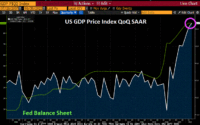There’s Lots of “Liquidity” in the Treasury Market, but at Higher Yields, in this Raging Inflation
Higher Yields Solve “Liquidity” Problems.
By Wolf Richter for WOLF STREET:
There is now a lot of handwringing on Wall Street and in the financial media about “liquidity” in the Treasury market. “Liquidity” means a gazillion things, but in this case, it probably means that there doesn’t seem to be a lot of appetite for buying, for example, 10-year Treasury securities at the current yield, and some of the auctions have seen less than stellar demand, as a lot of the big Treasury buyers have stepped away from the market, including large pension funds and life insurers, particularly in Japan. US banks have stopped adding to their $1 trillion in Treasury holdings. And the Fed is now reducing its $5.6 trillion in Treasury holdings by about $60 billion a month.
So who’d want to buy a Treasury security with a longer maturity at 3% or 4% yield, when CPI inflation is over 8%, with lots of signs that inflation will prove to be dogged, will pop up again just after folks thought it had been vanquished, and will pulls head-fakes on everyone? That’s what inflation did last time it took off, which was in the 1970s and early 1980s. So now, Wall Street and the financial media are expecting a lot of demand for a 10-year Treasury that yields just 3.9%?
There are buyers waiting for the 10-year yield to hit 4.5% before they buy. And once they’re satisfied, more buyers will emerge at 5%. And then once they’re satisfied, there will be more buyers at 5.5%, and once they’re satisfied, more buyers will emerge at 6%….
There is a huge amount of “liquidity” out there, waiting to be deployed in longer-dated Treasuries, and that includes me, but not at today’s puny yields, given where inflation is today and where it may be in a few years, with the real 10-year yield today being -4.5%.
Sure, if you scare investors out of their wits, they will buy 10-year Treasuries even if the yield is just 1%, because they know they’re going to get face value if they hold to maturity, which sounds like a tempting proposition when all heck is breaking loose.
But when all heck is not breaking loose, the equation of yield and inflation matters. And that’s where we are today.
Sure, higher yield means sellers get a lower price.
This is the other side of the coin: Higher yields mean lower prices for the current holders if they want to sell.
If I paid around $1,000 for a ten-year Treasury note in October 2020 at auction with a 1% coupon, I know today that I will get 1% interest per year for another eight years, and then I will get paid face value ($1,000). But inflation is now over 8%, and that 1% coupon will not compensate me for the ravages of inflation. So I might want to dump it. And if I do, I will pocket a big capital loss because the price would have to be low enough to generate the market yield to maturity of 3.9%. Plugging this into an online yield-to-maturity calculator tells me that I could sell my $1,000 bond for $734.
Or instead of taking a 26% capital loss and wash my hands off it, I can hold it to maturity and get $1,000 in eight years, plus eight years of 1% interest payments.
Higher yields solve all “liquidity” problems.
So, I can go on CNBC and complain that there is “no liquidity” in the Treasury market because I cannot sell my 10-year Treasury for a price that reflects a 1% yield or a 3% yield, when inflation is 8%. So there must be a liquidity problem. That sounds good. Maybe I can even persuade the Fed of my point of view to get them to, well, pivot.
Yet, there is plenty of liquidity, but with 8% inflation, the liquidity isn’t at a 1% yield, and not at 3%, and it may not be at 4% either.
The higher the yield, the more buyers show up – the more liquidity appears. And when the yield rises enough, at some point there will be more potential buyers than willing sellers, and amid this flood of liquidity, yields tick down. Higher yields solve all liquidity problems.
Instead of going on CNBC and complaining about not enough liquidity in the Treasury market, folks should go on CNBC and complain about yields being still too low – and prices too high – given the raging inflation.
Enjoy reading WOLF STREET and want to support it? Using ad blockers – I totally get why – but want to support the site? You can donate. I appreciate it immensely. Click on the beer and iced-tea mug to find out how:

Would you like to be notified via email when WOLF STREET publishes a new article? Sign up here.
![]()
[ad_2]
Source link


